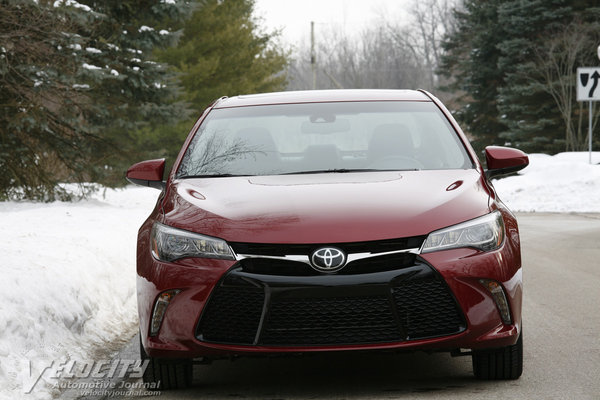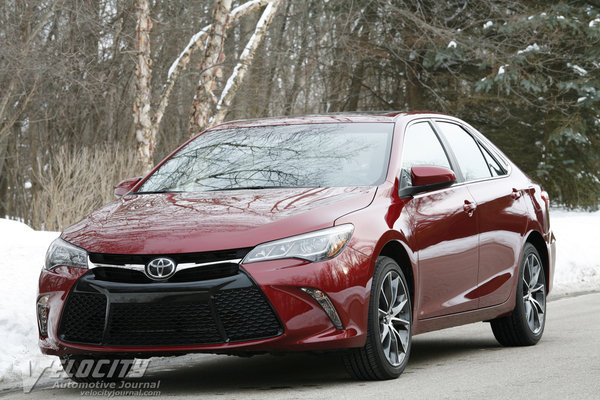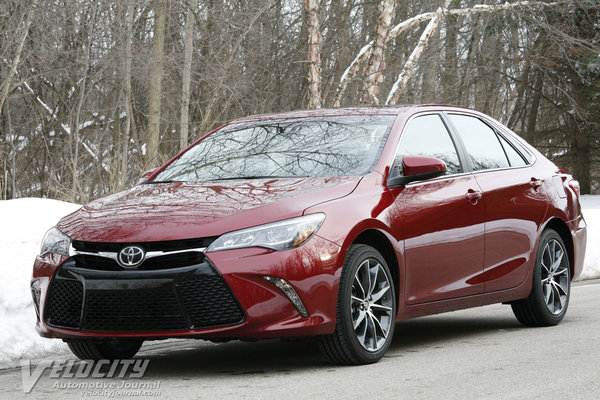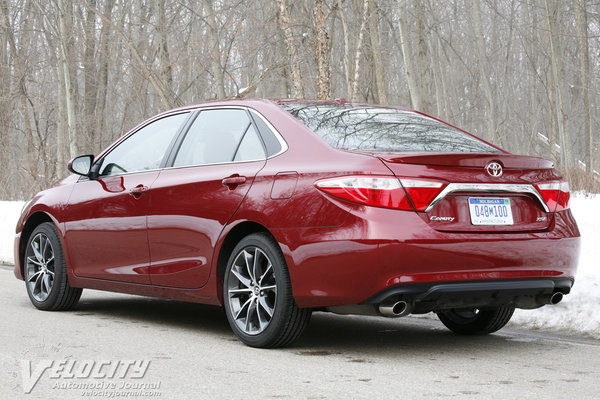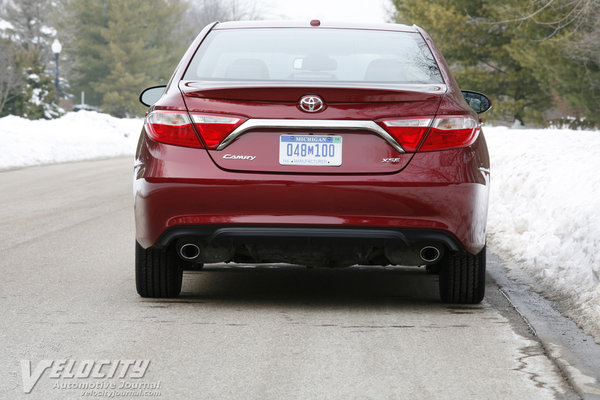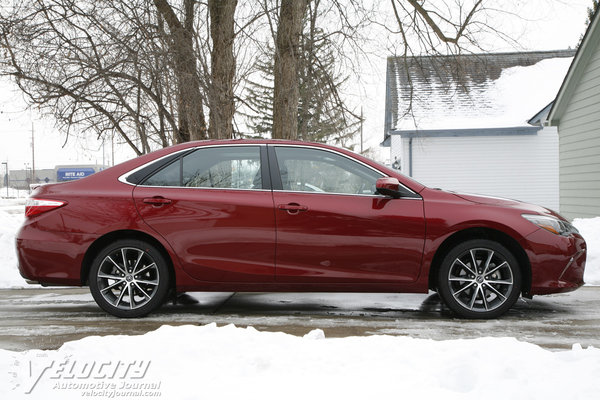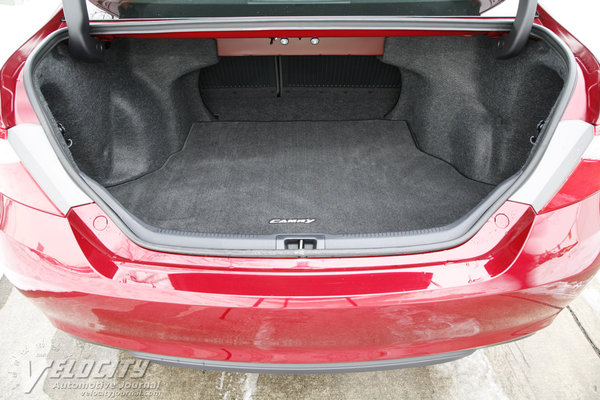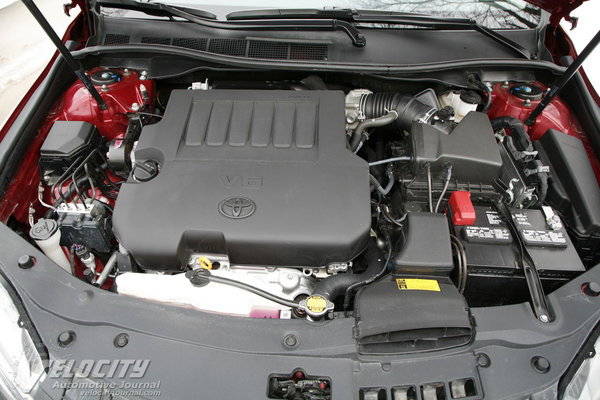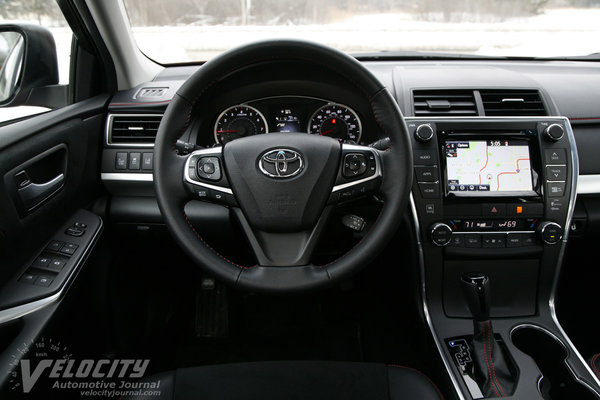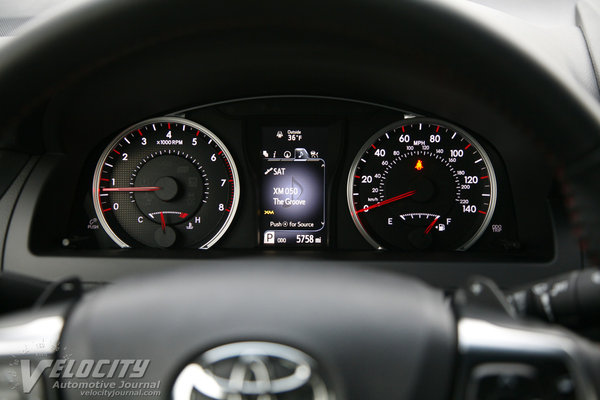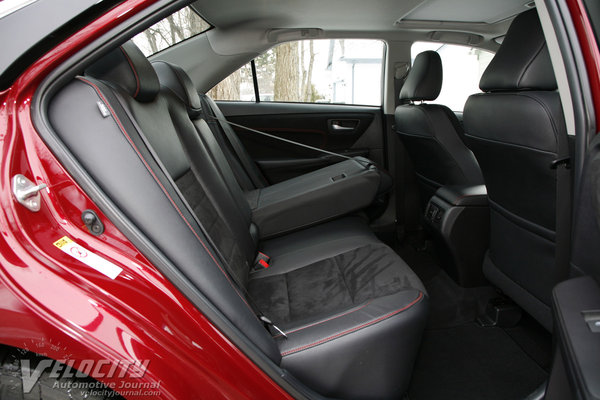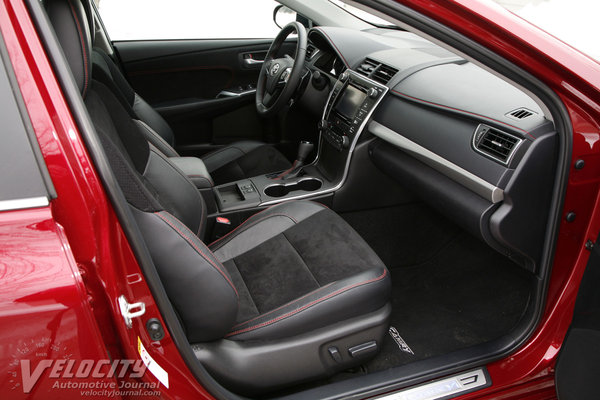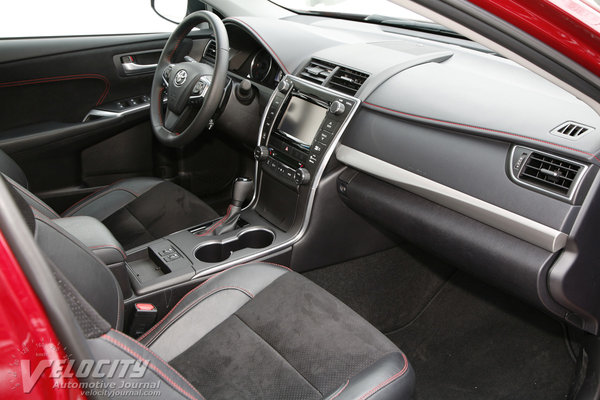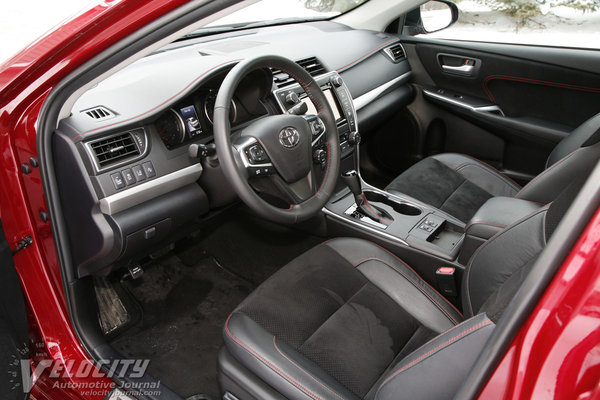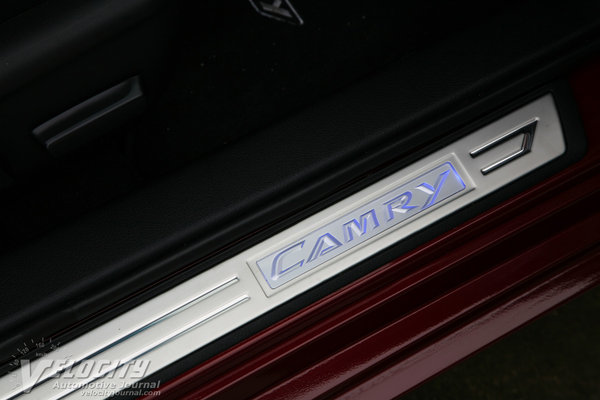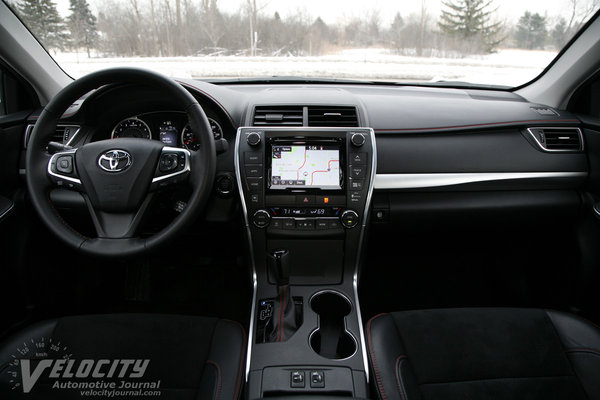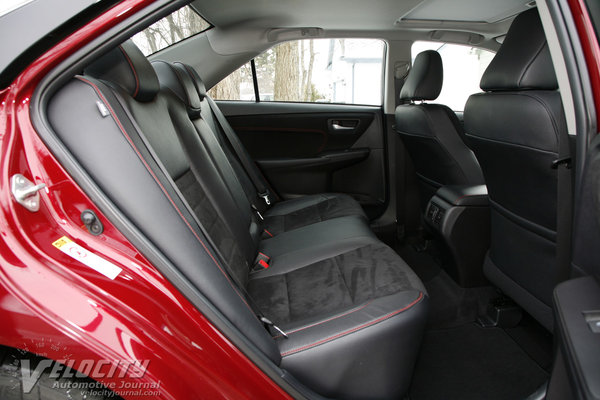2015 Toyota Camry XSE
06/01/2015
Shahed Hussain
In the early 1980s, Toyota introduced the midsize Camry sedan to the US market. Angular and nondescript, the Camry went almost unnoticed among the sea of other boring 4-doors from Japanese and American manufacturers. Over three decades, it gradually ascended to the top of the heap, consistently ranking among the best-selling family sedans in the US. Despite Toyota's success, competition from Honda, Ford, GM, and Nissan, and even Hyundai have chipped away the Camry's dominance.
Toyota sells the 2015 Camry in four trim levels, starting with the entry-level LE ($24,460), followed by the SE ($25,280), XSE ($27,660), and XLE ($29,995). All models are equipped with a standard 2.5L inline-4, while the XLE and XSE offer an optional 3.5L V-6. Both engines are mated to a 6-speed automatic. Our test vehicle was a Camry XSE V-6 ($31,730) with a few options such as the Blind Spot Monitor ($500), Entune(R) Premium JBL audio ($805), Technology Package ($750), Ruby Flare Pearl paint ($395), Illuminated Door Sill Enhancements ($299), Remote Start ($499), and Floor Mats ($325). The total added up to $35,768 including the $525 delivery and processing fee. We would skip most of these options, and just keep the Entune(R) audio and Technology Package, shaving a substantial $2,018 from the sticker price.
The Camry XSE is intended as the sport model in the lineup, so it benefits from some exclusive upgrades. Among them are 18-inch diameter alloy wheels with wider Michelin all-season tires, a sport suspension, dual chrome-tipped exhaust, LED daytime running lights, heated leather sport seats and Qi wireless charging capability for portable electronic devices.
Inside the XSE, the red-stitched leather sport seats are the most notable difference from less Camrys. The perforated Ultrasuede(R) seat inserts provide the necessary grip to keep the driver in place, especially since the side bolsters are relatively flat. The driver's seat has 8-way adjustability plus lumbar support, but the front passenger gets a basic 4-way adjustments. Long-legged occupants may find the front seat cushions do provide adequate thigh support. Heated front seats are much appreciated on cold winter mornings, and the Camry's heaters warmed up in a few minutes. Although rear seat occupants don't get seat heaters, they do benefit from ample legroom and headroom.
Gauges consist of a tachometer, speedometer, along with smaller indicators for coolant temperature and fuel level. A center information display shows trip computer, audio, and other minor vehicle status items. The leather-wrapped steering wheel includes audio, phone and trip computer controls. Dual paddle shifters are behind the steering wheel. Rectangular buttons on the left side of the dash engage/disengage the Blind Spot Monitor and stability control systems. On the center stack is an LCD display for the Entune(R) audio and navigation systems. The navigation system has a simple interface and provides clearly audible route guidance. Commonly used audio controls such as the volume and tuning knobs are within easy reach. Additional infotainment system buttons are located on either side of the display screen. Climate controls get a separate digital display along with dedicated knobs and buttons. A small storage bin ahead of the shift knob conceals the wireless Qi charging system, 12V outlet, along with a USB and auxiliary audio input. Dual cupholders on the center console are sized for the large drinks Americans prefer.
Although the standard 2.5L inline-4 is certainly adequate, it makes little sense to order a sport model with the base engine. Instead, our test vehicle had the all-aluminum 3.5L V-6 rated for 268-bhp @ 6,200 RPM and 248 lb.-ft. @ 4,700 RPM. The direct-injected V-6 is topped with dual-overhead cams and variable valve-timing (VVT-i). Fuel consumption for the V-6 is rated at 21/31 MPG (city/hwy.). The 4-cylinder betters the V-6 by 4 MPG in both city and highway ratings. During our test, chilly winter temperatures prevented us from getting representative fuel consumption data.
All Camrys are equipped with an electronically controlled 6-speed automatic sharing identical gear ratios for both 4-cylinder and V-6 engines. Both fifth (0.713:1) and sixth (0.608:1) ratios are overdrive. In the SE and XSE models, the automatic is tuned for faster shifts and downshift rev-matching in "S" mode. The V-6 gets a taller final drive ratio of 3.458:1 vs. 3.634:1 for the inline-4.
The suspension design consists of MacPherson struts with gas-filled dampers for both front and rear axles. In the rear, a dual link layout is coupled with the MacPherson strut. All Camrys get tubular stabilizer bars front and rear, except the XSE which substitutes solid stabilizer bars to further reduce body roll. SE and XSE models also benefit from sport-tuned dampers, springs, along with strut tower and trunk braces to increase body rigidity. All Camrys are equipped with 11.65 in. diameter ventilated front discs and 11.0 in. diameter solid discs at the rear. The XSE is equipped with 18-inch diameter alloy wheels and P225/45R18 all-season Michelin tires. All other Camry models get 17-inch or 16-inch diameter wheels. ABS and stability control (VSC) are standard. Steering is via a rack-and-pinion setup with electric assist. Steering lock-to-lock is 2.85 turns, typical for a midsize sedan.
Sport sedans are expected to have large diameter wheels, low profile tires and firm suspension tuning. But in this case, Toyota turned up the spring and damper stiffness a bit too far, at least for less than perfect pavement. On pristine roads, the Camry XSE provides an acceptably firm ride, but over the pitted roads in southeast Michigan, the ride quality is just too stiff for a mainstream midsize sedan. Partly responsible are the low profile Michelins, which cannot absorb road imperfections adequately, so nearly every impact and pothole is felt in the cabin via the stiff damper and springs. The smaller 17-inch wheels and P215/55R17 tires on the Camry SE and XLE are likely to provide superior ride comfort, but sacrifice some handling precision. What the sport suspension does offer is enhanced turn-in and direct steering response that is unexpected in a Camry. Minimal understeer and reduced body roll are proof that Toyota is serious about changing the Camry's character. Another surprise was the powerful brakes and the unexpectedly firm pedal feel that provide confidence under hard braking. The firm suspension tuning also minimized brake dive and weight transfer to the front wheels.
We had no complaints about the 3.5L V-6, with its more than adequate 268-bhp and 248 lb.-ft. of torque. Power delivery is linear across the rev range, with excellent throttle response. The V-6 will effortlessly accelerate the Camry past 90 MPH, aided by the nearly seamless shifts of the 6-speed automatic. At highway speeds, the V-6 is barely audible, but we noted some wind and tire noise typical for similar midsize sedans.
Traditional Camry customers will likely skew toward the XLE or SE, but the XSE is evidence of Toyota's drive to widen the appeal of its best-selling sedan. As a niche model, the Camry XSE is more overtly sporty than most of its American and Japanese competition. The Accord and Sonata are both available in Sport models, but neither can match the power of the Camry's V-6. So despite the many choices among midsize sedans, enthusiasts with family obligations will find the Camry XSE has few rivals.

